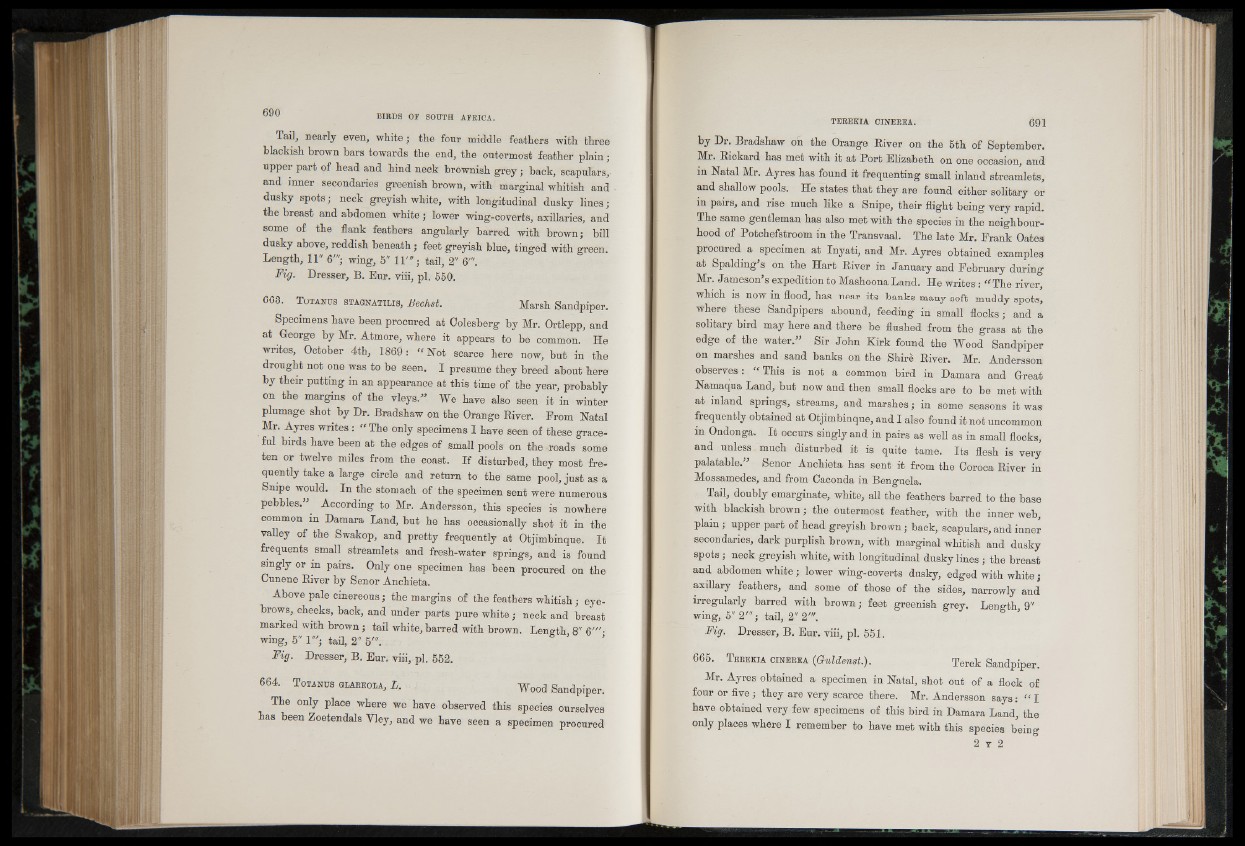
Tail, nearly even, white; the four middle feathers with three
blackish brown bars towards the end, the outermost feather plain;
upper part of head and hind neck brownish grey; back, scapulars,
and inner secondaries greenish brown, with marginal whitish and
dusky spots; neck greyish white, with longitudinal dusky lines;
the breast and abdomen white; lower wing-eoverts, axillaries, and
some of the flank feathers angularly barred with brown; bill
dusky above, reddish beneath; feet greyish blue, tinged with green.
Length, 11" 6"'; wing, 5" M f l tail, 2" 6"'.
Fig. Dresser, B. Bur. viii, pi. 550.
663. T otanus stagnatilis , Bechst. Marsh Sandpiper.
Specimens have been procured at Oolesberg by Mr. Ortlepp, and
at George by Mr. Atmore, where it appears to be common. He
writes, October 4th, 1869 : “ Mot scarce here now, but in the
drought not one was to be seen. I presume they breed about here
by their putting in an appearance at this time of the year, probably
on the margins of the vleys.” We have also seen it in winter
plumage shot by Dr. Bradshaw on the Orange River. From Natal
Mr. Ayres writes : “ The only specimens I have seen of these graceful
birds have been at the edges of small pools on the roads some
ten or twelve miles from the coast. If disturbed, they most frequently
take a large circle and return to the same pool, just as a
Snipe would. In the stomach of the specimen sent were numerous
pebbles.” According to Mr. Andersson, this species is nowhere
common in Damara Land, but he has occasionally shot it in the
valley of the Swakop, and pretty frequently at Otjimbinque. It
frequents small streamlets and fresh-water springs, and is found
singly or m pairs. Only one specimen has been procured on the
Cunene River by Senor Anchieta.
Above pale cinereous; the margins of the feathers whitish; eyebrows,
cheeks, back, and under parts pure white; neck and breast
marked with brown; tail white, barred with brown. Length 8" 6'"-
wing, 5" 1"'; tail, 2" 5"'. . ’
Fig. Dresser, B. Eur. viii, pi. 552.
664. T otanus glareola, L. Wood Sandpiper.
The only place where we have observed this species ourselves
has been Zoetendals Yley, and we have seen a specimen procured
by Dr. Bradshaw oh the Orange River on the 5th of September.
Mr. Rickard has met with it at Port Elizabeth on one occasion, and
in Natal Mr. Ayres has found it frequenting small inland streamlets,
and shallow pools. He states that they are found either solitary or
in pairs, and rise much like a Snipe, their flight being very rapid.
The same gentleman has also met with the species in the neighbourhood
of Potchefstroom in the Transvaal. The late Mr. Frank Oates
procured a specimen at Inyati, and Mr. Ayres obtained examples
at Spalding s on the Hart River in January and February during
Mr. Jameson’s expedition to Mashoona Land. He writes : “ The river,
which is now in flood, has near its banks many soft muddy spots,
where these Sandpipers abound, feeding in small flocks; and a
solitary bird may here and there be flushed from the grass at the
edge of the water.” Sir John Kirk found the Wood Sandpiper
on marshes and sand banks on the Shire River. Mr. Andersson
observes: “ This is not a common bird in Damara and Great
Namaqua Land, but now and then small flocks are to be met with
at inland springs, streams, and marshes; in some seasons it was
frequently obtained at Otjimbinque, and I also found it not uncommon
m Ondonga. It occurs singlyand in pairs as well as in small flocks,
and unless much disturbed it is quite tame. Its flesh is very
palatable.” Senor Anchieta has sent it from the Ooroca River in
Mossamedes, and from Caconda in Benguela.
Tail, doubly emarginate, white, all the feathers barred to the base
with blackish brown; the outermost feather, with the inner web,
plain ; upper part of head greyish brown; back, scapulars, and inner
secondaries, dark purplish brown, with marginal whitish and dusky
spots; neck greyish white, with longitudinal dusky lines ; the breast
and abdomen white; lower wing-coverts dusky, edged with white;
axillary feathers, and some of those of the sides, narrowly and
irregularly barred with brown; feet greenish grey. Length 9"
wing, 5" 2 " ; tail, 2" 2"’.
Fig. Dresser, B. Eur. viii, pi. 551.
665. T er e k ia c in e r ea (Quldenst.). Terek Sandpiper.
Mr. Ayres obtained a specimen in Natal, shot out of a flock of
four or five; they are very scarce there. Mr. Andersson says: “ I
have obtained very few specimens of this bird in Damara Land, the
only places where I remember to have met with this species being
2 y 2